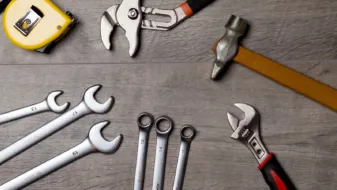We all know how frustrating it is when a home appliance breaks down and we can’t find professional repairers to fix it for a decent price. It’s often cheaper and easier to chuck it out and buy a new one than it is to repair devices. But this means we’re adding to the ever-growing mountain of global junk.
Throwing our old electrical appliances into landfill and buying replacements is expensive for us, but it’s even more costly for our planet.
What’s wrong with dumping our old home appliances?
From washing machines and fridges to electrical goods and kitchen appliances, our household goods include a lot of potential e-waste (electronic waste) – that’s anything with plugs, cords and electronic components. The world produces about 50 million tonnes of e-waste every year, most of which is never recycled. Electrical waste contains lots of harmful chemicals that – if not handled properly – end up in our soil, water and air. It’s sometimes illegally exported to countries that don’t have protective laws in place. This means that anyone working to recover valuable materials from e-waste in these countries is exposed to numerous harmful substances. This is particularly harmful for pregnant women and children.
This is why it’s so important to recycle e-waste, ensuring that it doesn’t end up in landfill.
What is the right to repair appliances?
Once we’ve bought something, we can mend it if it breaks, right? Wrong. Although repair is technically legal, a lot of manufacturers ensure that there are limits on our access to spare parts that would enable us to fix appliances. After all, they would rather we sent an appliance back to them for repair, paid them for the spare part or even bought a brand-new appliance. This way they can set the price they want and make more money.
This would be less of an issue if products were designed to last, but many of them aren’t. You may have heard of planned obsolescence, a business strategy where manufacturers deliberately build appliances to stop working after a certain period. This keeps consumers' buying and profits flowing. In a similar way, software updates for mobile phones and laptops aren’t designed to be compatible with each other, so people have to upgrade rather than repair.
Fortunately, people have been taking notice and campaigning to carry out repairs themselves. In response to concerns around sustainability, repair cafés have sprung up around the world. These are places where people gather to repair everyday objects, sharing their tools, knowledge and skills so that goods can be repaired and waste avoided.
The right to repair is exactly what it says – it’s about a consumer’s right to repair the goods they purchase. Supporters want companies to provide:
-
Products that are repairable
-
Access to official repair manuals
-
Access to spare parts and affordable repair services
The UK has now taken its first significant step towards supporting this right with the new right to repair laws.
What does the UK’s new ‘right to repair’ law involve?
The new law means that manufacturers now have to make repair information and spare parts available for repairs for up to ten years for certain new white goods and televisions. It aligns Great Britain with the EU and Northern Ireland, where the same legislation came into effect in March 2021.
-
Manufacturers of washing machines, washer-dryers, dishwashers, fridges and televisions are now legally required to provide consumers with spare parts for ‘simple and safe’ repairs, such as fitting a new drain filter or replacing a tray in a fridge freezer. It also requires manufacturers to make parts for trickier repairs (such as the heating element on a washing machine) available to professional repairers.
-
Spare parts will have to be available within two years of a product going on sale and must remain available for either seven or ten years after it has been discontinued, depending on the part.
-
New devices now have to come with repair manuals so that consumers can fix their appliances themselves. However, some of these manuals will only be made available to professional repair companies.
-
Appliances must be designed in such a way that they can be dismantled using conventional tools.
This new legislation is about giving consumers a choice. It gives us the right to fix products we’ve bought - or to pay a third party to fix them. It should mean these appliances will now become easier to repair and cheaper to run. And it aims to extend the life cycle of certain devices and appliances by up to ten years.
This should go some way towards reducing the 300,000 tonnes of electrical waste that is thrown out by UK households and businesses each year.
What’s wrong with the new law?
Just like your dodgy appliances, there are key parts missing.
-
There is no cap on how much manufacturers can charge for spare parts and VAT hasn’t been removed to reduce the cost of professional repairs, so the new law doesn’t make repair more financially attractive to consumers. It also allows the practice of ‘bundling’ multiple components together so that you have to pay for the whole bundle, even if you only want one small part of it.
-
The new rules only apply to appliances bought on 1 July 2021 or after and they only apply to a few products. The new law doesn’t cover smartphones, laptops, cookers, microwaves, hobs or tumble dryers.
-
The new law excludes consumers and community-repair initiatives from the right to access spare parts and manuals, some of which will only be provided to professional repair services.
-
Manufacturers have a two-year period before they have to make replacement spare parts available. This means that if you buy an appliance now, there may not be any spares available to buy until 2023.
Putting just one of these in perspective, let’s say that the door seal on your current washing machine gets damaged. Because you bought the machine before 1st July 2021, the manufacturer is not legally obliged to provide a new one for you. So, once your warranty period is up, if the manufacturer won’t provide you with replacement parts, you may still have no option but to throw out your old appliance and buy a new one.
And that’s particularly concerning because the UK produces more e-waste per person than anywhere in the world, apart from Norway.
What’s next for the right to repair?
Let’s hope that future laws will support the right to repair for more appliances, as well as extending the time frame of 10 years. The laws should include consumers and repair cafés, as well as professional repair services. And, as cost is the main reason people buy new products instead of repairing old ones, there should be fiscal incentives to help people make choices that will prevent waste.
In the meantime, a lot of people around the world are taking matters into their own hands and working to change things for the better. Organisations such as The Restart Project are campaigning against the barriers that prevent us from repairing the items we own. People are increasingly rejecting our throwaway culture and businesses are coming under more pressure than ever to play their part. Some are already offering replacement components on their products as standard and others are focusing on creating products that will last a lifetime, but are also easy to disassemble and repair if necessary.
E-waste is now the fastest-growing domestic waste stream on earth and is expected to more than double by 2050. If we can’t repair or reuse, we need to recycle responsibly and ensure that products go to the right places and not to landfill. However, we can’t only rely on recycling to deal with the waste we generate. The right to repair is not just about fixing appliances – it’s about working towards a sustainable future and fixing our planet.



